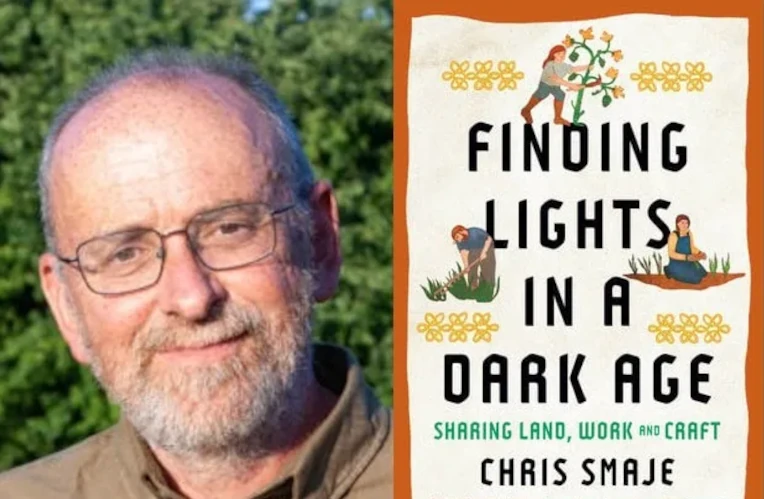Copyright Resilience

Finding Lights in a Dark Age: Sharing Land, Work and Craft by Chris Smaje Chelsea Green Press Reviewed by Mary Wildfire I have read and reviewed Chris Smaje’s first book, Small Farm Future, and his second one, No to a Farm Free Future. This one is like an elaboration of the Small Farm Future; it looks at essentially the same questions, although it does not spend a lot of time spelling out the reasons we’re in trouble, the reasons an impending dark age seems likely…perhaps because in the few years since Small Farm came out, we’ve made so much progress toward that collapse that it isn’t necessary any longer to argue that More of the Same is not likely to be in the offing for the next few decades. Early on, Smaje makes the point I’ve recently heard existential risk and collapse researcher Luke Kemp make on both Nate Hagens’ Great Simplification podcast, and Rachel Donald’s Planet Critical: a dark age is not necessarily bad for most people. Often the common people get taller and healthier. So why do we see these episodes as “dark”? Well, likely because the people with pens in their hands after a collapse are the former elite—and for them a collapse is a catastrophic loss of privilege. Essentially, Smaje’s object in this book is to explore the ways we could make the coming dark age more good than bad. A key, according to Smaje, is to recognize that, for various reasons, national governments won’t help. We must find solutions bottom-up. And developing healthy communities will be central. Smaje champions distributism, which seems to mean both better distribution of land, and subsidiarity, that is, making decisions at the most local level feasible. He points out that populism can be progressive. “A world of lower energy use needn’t be something to fear. A world of unexpected energy squeezes and global competition over energy resources might be,” he says, and “We now need {stories} in which we dial down our sense of ourselves as world-transforming history-makers and instead tell tales of ourselves as heroic local livelihood makers.” Given his penchant for a future in which most people are either running small farms or other small businesses, Smaje must tackle the problem of access to land. He doesn’t buy the common claim that everyone wants to move to the city, but points out that land is far too expensive for young people to just start farming—despite the poor potential for farming to be profitable. He often uses his own experiences as a landowner and small farmer to illustrate the ways making a living as a farmer is currently tremendously difficult—people move to the city because they can’t make a living as farmers, when they have to compete with heavily subsidized agribusiness. But after the fossil fuels that underpin the current system vanish, everything will change. Smaje spends many pages considering how commons work, how they succeed or fail, and how they can be part of a system in sync with private ownership of land. He says that there are many different sets of rules for what ownership of land means and points to the “extremist” nature of modernist/colonial notions of ownership, “built on the foundations of Roman law, a legal code befitting a predatory, patriarchal, colonial, expansionist colonial empire. With the necessary amendments and updates, it has served modern capitalist societies, which have most of these characteristics, pretty well. But it’s only one form of private property—unfortunately, an especially ecocidal and antisocial version that’s come to dominate the world.” In a chapter focused on families, he says they were actually not much bigger in the past, and have always been important—although different societies have different ideas of who is in a family. He believes, reasonably in my view, that life, notably life on farms and in small towns, will continue to be organized around families. Here his greatest concern is to avoid slipping into past patterns of patriarchy. But he takes heart from examples such as the Zapatistas and Rojava, and especially the Brazilian Landless Workers Movement, which appropriates unused land for communities of poor people. He says that in a formative meeting, despite there being few women present and despite a culture of machismo, a decision was taken to make everyone equal regardless of age or gender. Will the future involve hordes of desperate refugees converging on places where agriculture is still viable, and being met with hostility and violence? Sometimes this will no doubt happen, but Smaje suggests that often landowners will be incentivized to work out arrangements with newcomers, refugees, to create “a local livelihood community.” If you own 500 acres you’ve been farming with tractors and chemicals and now there is no fuel for the tractors and no pesticides or fertilizers, you may look at the arriving refugees not as a threat but as a godsend. Developing local commons would go along with this and can’t be rushed or imposed via a template. In a chapter focused on making a living, he mentions the need to preserve some highly useful “middle tech” (my term, not his). The high-tech bells and whistles so glorified today will likely disappear, and much of it is not all that useful anyway, but some twentieth century tools and discoveries will be worth the trouble to keep available. Over and over, he makes the point that prioritizing local provisioning is a way to gain security; the “free market” exists for profit and will disappear when the profit dies. “This gap between present reality and sustainable reality, with no clear path between, is one reason why I think we’ll find our way to sustainable reality by a Dark Age route.” Here’s his recipe for a revolution: “cancel the debt, destroy the records, reallocate the land, turn off the computer.” He suggests there is more scope for useful politics on the local level, and tells a lovely story about a guy who started a new party in his own town of Frome in England. Soon the public elected only people from this party to its council, and this guy became mayor—where he enjoyed making fun of himself with his trademark red shoes, shorts, and a chain of office, once made from vegetables from Smaje’s farm. But he then goes from politics to religion, saying we need a new cultural underpinning such as religions supply. The final chapter is fiction, a little story of someone late in this century going from London to Frome, seeing and describing and reflecting on the changes from today. For me this was the best part of the book and certainly the easiest read. I had to read this book twice. Smaje’s past as a university professor is obvious in his diction, use of abstractions, wandering around a lot of topics. Not like Saying No, because that one had a clear, narrow focus. This one, I think, would have benefited from an outline in the introduction, to clarify the train of argument, spelling out in a sentence or two his intentions for each chapter. Who needs to read this book? Mostly, anyone who sees the dark age coming and is worried about it but interested in discussion about how we might have a hand in guiding the trajectory, in our own locales so that the future is, as Nate Hagens likes to say, “better than the default.” It looks at and dissects many aspects of that future, from politics and religion to livelihood making, to family life. It would be a good book to pass around among members of a local group pondering what they might do to create a “local livelihood community.”



